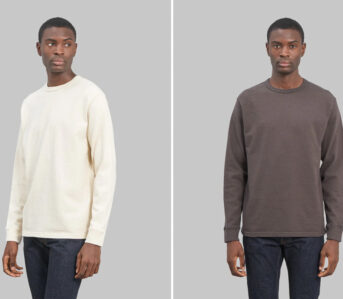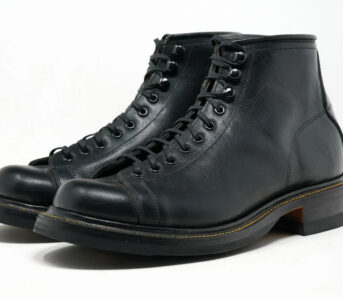
Sometimes, you have an experience that makes you realize you’ve been thinking about something totally wrong. I recently had such an experience while touring the facilities at TALEX in Osaka, Japan, arguably the best lens manufacturer in the world.

Exterior of the TALEX Headquarters in Osaka, Japan
Before I get into the history of the company, Part II of this article, indulge me in a thought experiment: when you purchase a pair of sunglasses, what do you think about? Perhaps, if you’re like me, you consider a few factors:
- Brand: What’s the reputation of the manufacturer? (e.g. Persol, Ray-Bans, etc.)
- Heritage: What’s the history of the company? (e.g. Since 1938, etc.)
- Influence: Have any notable people worn them? (e.g. Steve McQueen, Audrey Hepburn, etc.)
- Origin: Where are they made? (e.g. Italy, France, Japan, USA)
- Shape: What’s the profile of the glasses? (e.g. round, square)
- Material: Style and quality of the frame (e.g. acetate, wire, etc.)
- Aesthetics: Do they suit your face? (e.g. round face, angular face, etc.)
- Comfort: How comfortable are they? (e.g. do they pinch, do they splay, etc.)
- Weight: How heavy are they? (e.g. heavy, light, etc.)
- Price: How much they cost? (e.g. $100-$500)
- Colors: Do the colors of the glasses coordinate with pieces in your in your wardrobe?
- Ethics: Are they sustainable? Do they employ fair labor practices?
Maybe, if you care about your eye health, you might ask the sales associate whether they’re polarized or not. But when you’re assured that the lenses are, in fact, polarized, I assume that you don’t have any follow-up questions and the conversation stops there.
You may have realized, at this point, that most of the questions listed above relate to the frames. However, if you think about it, the frames ought to be a secondary consideration. Presumably, the primary reason you’re buying a pair of sunglasses is for the lenses, to reduce the amount of glare or eye strain that you’ll experience in high-light environments. In other words, the lenses are what actually matters.
The sunglasses industry, as a whole, has done a lot to invert this relationship, putting more money into making fashionable frames, while sourcing cheaper and cheaper lenses. We’ve been taught and conditioned to think of sunglasses as a fashion accessory, a stylish accent. Moreover, few, if any of us, have ever really been taught how to evaluate lenses, whether polarized or not. I mean, they’re all the same, right?
The short answer is no, very much no.
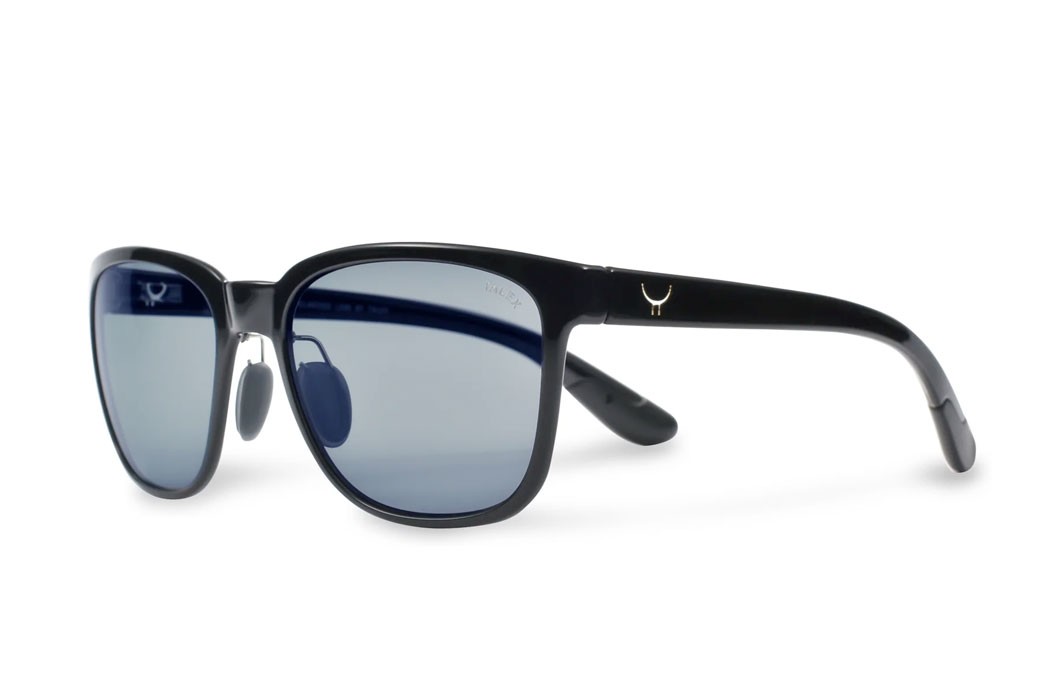
A pair of Shinzo Tamura Namba sunglasses.
Over the course of this two-part article, I’m going to do my best to take you through a pretty exhaustive analysis of all the things that go into a quality pair of polarized lenses, building on the great reporting of my friend and colleague, David Shuck. By the end of this series, you’ll probably know more about lenses than you probably ever wanted to know, but you’ll at least be equipped to make an informed decision the next time you’re in need of a pair of shades.
If you need a quick overview of polarization technology and how sunglasses impact eye health, please open up a two new tabs and quickly read Polarized Sunglasses: How Do They Work? & Sunglasses and Eye Health with Shinzo Tamura.
Polarization Explained
If you’re short on time, I’ve provided a quick version of both articles below to ground our discussion of polarization going forward. So, let’s quickly answer three essential questions:
- What is polarization?
- How does polarization work?
What is polarization?
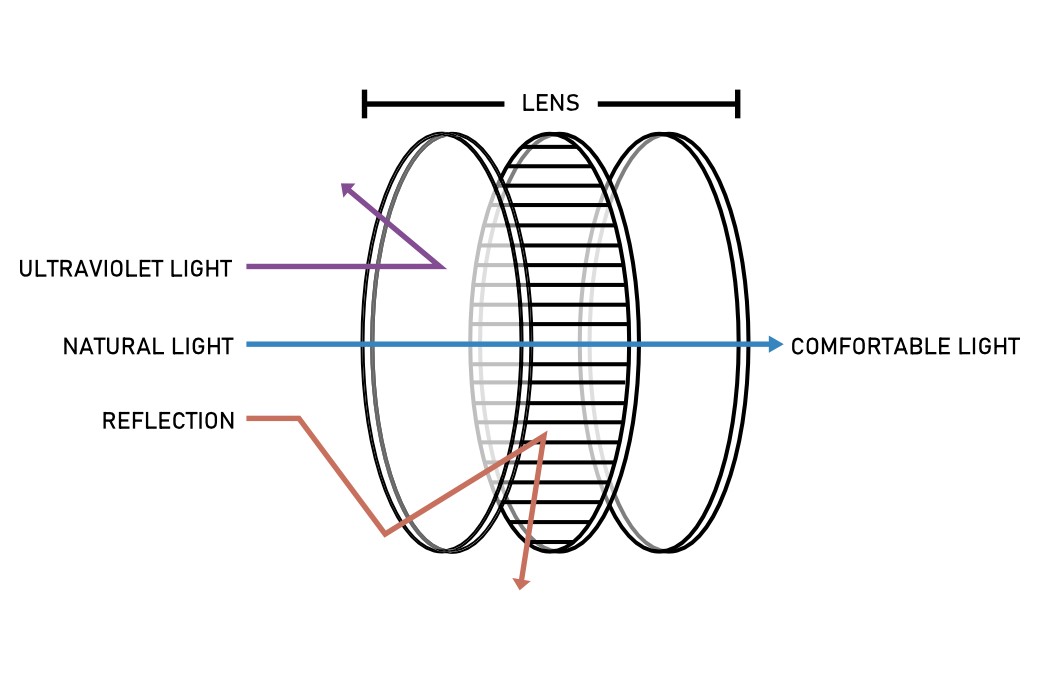
Polarization is a type of optical filter that allows select rays to pass through.
Polarization is an optical filter that allows waves of a certain orientation to pass through, while selectively blocking others. While most glasses offer some level of protection from the sun’s harmful rays (UVA & UVB), Polarization goes a step further, reducing glare caused by stray or errant reflections.
How does polarization work?
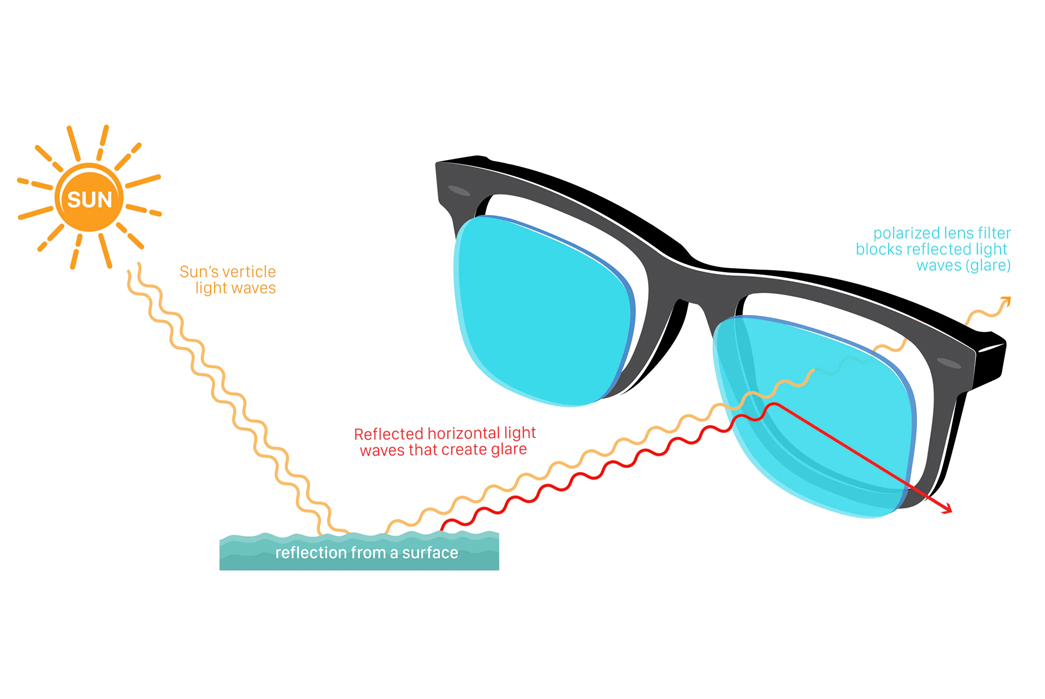
Polarized sunglasses filter out errant rays that have reflected off of uneven surfaces.
Most surfaces are uneven. As such, when light hits an uneven surface, its rays scatter in all directions. Polarized lenses operate like venetian blinds, blocking those high-frequency rouge rays and forcing them into a specific orientation in a manner that reduces their intensity.
The Basics of Polarization Quality
Now that we understand the basics of polarization, let’s talk about polarization quality. All polarized lenses deploy some form of the filtration process described above, but the degree of protection they offer are highly variable. In other words, not all polarized lenses are created equal. When buying polarized lenses, the commonly accepted gold standard are lenses that filter out 99% of UVA & UVB rays. This could be sold under two formats:
- 100%, or >99%, UVA/UVB Protection
- 100%, or >99%, UV 400 Protection

An independent review of a variety of well-known sunglass brands, sold at a different price points, showed little correlation between price and quality.
However, independent tests conducted by the Japanese government and other optician agencies have shown that most manufacturers exercise their own discretion in providing protection against UV light. To make matters worse, sunglasses sold in the US are not required to adhere to the American National Standards Institute (ANSI) recommendations, a non-profit organization that provide guidelines to protect consumers against known harms. However, you can always ask whether sunglasses meet the ANSI Z80.3-2018 UV blocking requirements.
In addition to failing to provide sufficient protection from UV light, poor quality polarized lenses can introduce other undesirable optical effects. They can cause distortion, uneven distribution of filtered light, or introduce sway, a perceptible shift in one’s environment, both of which are known to cause both headaches, migraines, and eye-fatigue. I’ll detail each of these unsavory attributes a little further on in this article.
Testing Polarized vs. Non-Polarized

Looking in and out of polarized lenses.
Now that we understand the difference between polarized and unpolarized lenses, let’s learn how to quickly definitively differentiate between the two. There’s a very easy test to determine whether or not a pair of sunglasses is polarized or not:
- Turn the sunglasses vertically, so that you can’t put them on your face.
- Look through the lens.
- Slowly twist the glasses until they resume the horizontal position necessary to put them on your face.
It’s polarized: As you twist the glasses, you should see everything darken. (See the bricks in the above image).
It’s NOT polarized: If you observe no meaningful environmental change, they’re not polarized lenses (no matter what a savvy sales associate may say to the contrary).
What you’re effectively observing during this test is those horizontal slats we talked about earlier kicking into effect. These horizontal slats act like shades, screening erratic rays of light by selectively letting light pass through in a single direction. The darkening effect is due to the fact that less light is able to pass through the lens and meet your eye; it’s the same principle using Venetian blinds to selectively control the amount of light that enters your room.
Assessing Polarization Quality
Once you’ve determined that the lenses are in fact polarized, you can move on to assessing the quality of the polarization. You cannot, yourself, test the percentage of UV filtration; however, most opticians and some reputable sunglasses manufacturers will have the tools on hand to test or demonstrate the degree of UV filtration.
1. Lens Material: Distortion
When light passes through polarized lenses, depending on the quality of the lenses you may observe may observe severe or partial distortion. Distortion refers to sporadic or splotchy directionality of light after passing through the lens.
The way to test this is to put the lens, or glasses over a light box and observe the distribution of the light. What you’re looking for is an even band of light across the middle of the glasses that diffuses towards the edge of the lens. This will show you that polarized light is being evenly distributed across your eyes. Speckled or distorted polarization has been shown to not only degrade polarization performance, but also to cause headaches and other eye strain related ailments.
2. Lens Curve: Full- vs. Partial-Balance
This is known as the “sway test.” Look at a fixed point, a pole, or a strong vertical line is recommended. Stare at your chosen point with your naked eye; keep looking at that point as you put the glasses your considering on to your face. If you observe a shift, or a flutter, whereby the object appears to move to the left or the right, the curvature of the lens is not properly balanced.
This, too, has been documented to cause eye-strain, headaches, and migraines when worn for prolonged periods of time. When you experience a properly balanced lens, like TALEX’s lenses, the object will appear stationary, and you will not be able to observe a meaningful difference.
3. Lens Flatness: Planar Consistency
Optical-grade pieces of glass are lapped and polished to be extremely flat on one or both sides, usually within a few tenths of a nanometer. Non-flat lenses create an effect that’s similar to a phenomenon called “thin-film interference,” those uneven, splotchy colors you sometimes see reflected in soap bubbles and oil films on water.
What you’re observing is reflected waves interfering with one another, creating visible patterns of light and dark bands. As with the other forms of optical distortion described above, this is known to cause headaches, migraines, and eye strain.
Glass Color: Optical Effects & Contextual Benefits
Glass color has an effect on which spectra of light can pass through the lenses, achieving different optical effects. Each color effectively acts as another filter, which, when used in tandem with polarization, selectively allows certain hues to pass through the lens and meet your eyes. While it may be cool to wear different colored lenses just for kicks, it’s also important understand their different situational applications.
It’s important to note that the color of the lenses has no impact on its ability to block UVA & UVB light. This is achieved through the addition UV-absorbing chemicals, which are usually colorless, and added to directly to the polarized filter. As such, you should always consider the base level of UV protection offered by a lens maker before considering lens color. The reason being without sufficient UV protection, dark-tinted lenses can cause more eye damage than not wearing sunglasses at all, because one’s pupils will widen to accommodate the darker environment and expose the eyes to more UV rays.
That said, below is a guide to explain the difference between some of the most common lens colors on the market and their contextual uses:
-
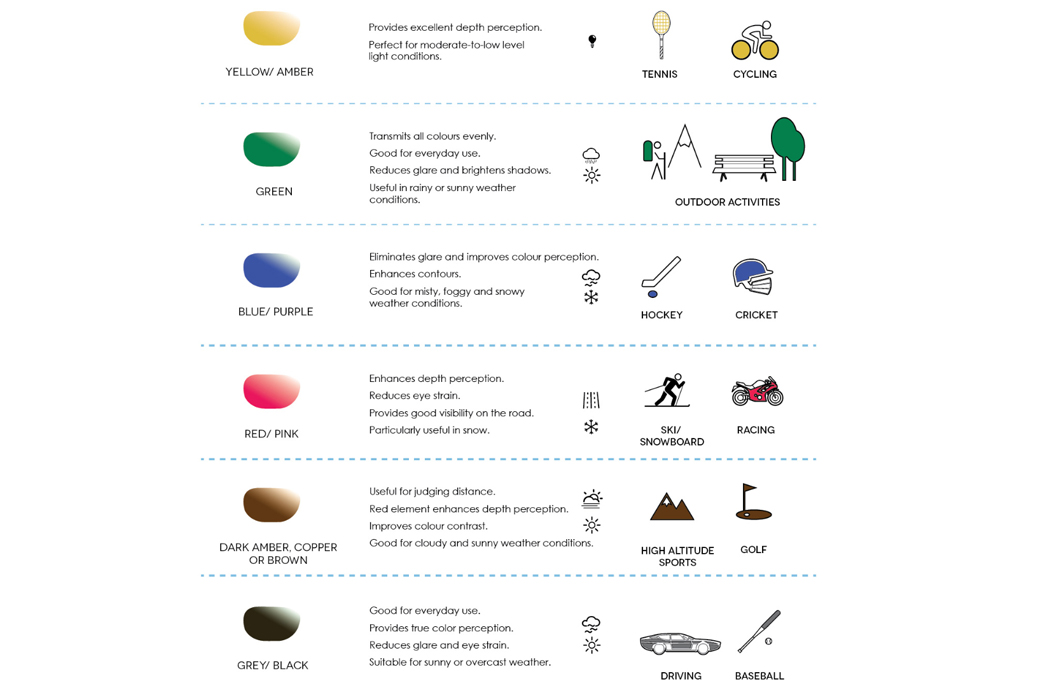
An overview on how to pair lens color with the appropriate recreational activity
Yellow: Yellow lenses are ideal for indoor ball sports (except when the color can hide a yellow tennis ball), nighttime activities, or driving in the fog. The same principles apply to orange tinted sunglasses, which increase contrast in foggy, hazy, and low-light conditions.
- GOOD FOR: Indoor Sports, Night-time Activities, Fog
- Green: Green softens strong light while creating a dull green cast, known to be one of the most somatically soothing hues. Green has been shown to have a calming effect on the nervous system, probably due to the fact that humans evolved in natural environments. In Japanese, there’s even a word for the therapeutic benefits of being in nature: shinrin-yoku (森林浴), which literally translates as “forest bathing.” So if you have you have green thumb, you might also find you also favor green lenses. Finally, green also sharpens colors in the natural environment, making them the ideal choice for hiking or outdoor activities that take place in verdant settings.
- GOOD FOR: Hiking & Outdoor Activities in Green Environments (Tennis, Baseball, Golf)
- Blue & Purple: Blue, purple, or amethyst lenses can be particularly useful in snowy or all-white environments, because white snow will naturally reflect the yellow of the sun. This makes purple lenses the ideal choice for winter activities like skiing and alpinism, helping to prevent snow blindness while enabling one to see the textural differences in a largely undifferentiated environment.
- GOOD FOR: Alpinism, Skiing, Snowboarding
- Red & Pink: Red and pink lenses increase the contrast between low vibrancy and high vibrancy colors by filtering out blue light. This is can be observed in the spectral dip shown in the graph shown below. Selectively filtering the middle range of the color spectrum makes darks appear comparatively darker and lights appear comparatively lighter. This is particularly useful in high-speed environments, like when driving a car. You’ll notice that you can more easily see road signs, lane markings, and the readings on your odometer as you cruise down the highway.
- GOOD FOR: High-Speed Activities, Driving
- Brown: Amber or brown lenses filter out blue light, reduce glare, brighten your vision on overcast or cloudy days, and increase contrast and visual acuity.
- GOOD FOR: Cloudy/Overcast Activities
- Grey: Grey is the most popular neutral tint, allowing your eyes to perceive colors in their purest form by virtue of filtering colors ‘relatively’ evenly. Grey is made from black and white; since black contains all the colors of the rainbow, while white contains none, when blended in a 25-75 (light grey), 50-50 (mid grey), or 75-25 (dark grey) ratio, you’re proportionately reducing the vibrancy, or brightness, of all colors that pass through the lens.
- GOOD FOR: Seeing True Color, Most Day-to-Day Applications
Conclusion
You’re now a self-taught expert in polarized lenses. Using this thorough grounding in the principles of high-quality polarized lenses, I want to introduce you to one of the best lens makers in the world, TALEX, and take you on a behind the scenes tour of what goes into producing handcrafted polarized lenses.


